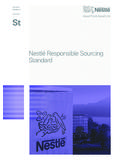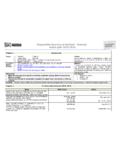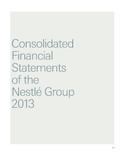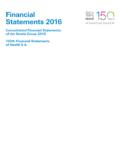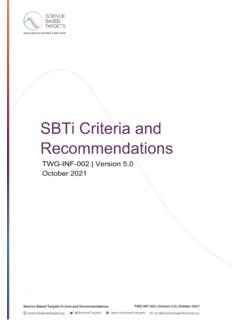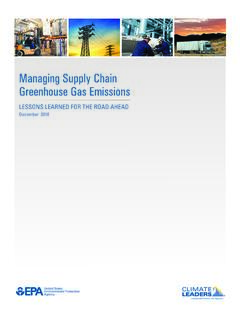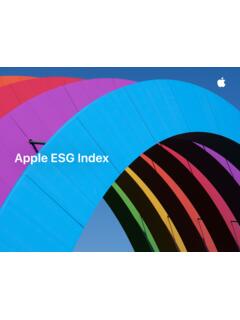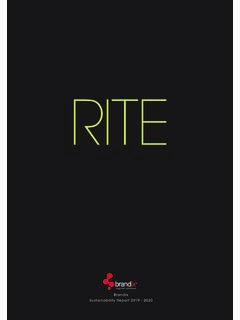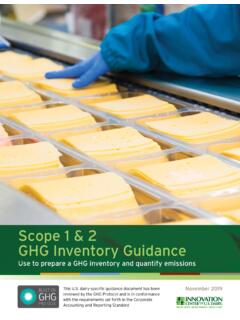Transcription of Reporting Scope and Methodology for ESG Key Performance ...
1 Reporting Scope and Methodology for ESG Key PerformanceIndicators Reporting Scope and Methodology for ESG Key Performance IndicatorsIntroduction Nestl has engaged EY to provide independent assurance of nine selected Environmental, Social and Governance (ESG) key Performance indicators (KPIs) of high strategic importance to our business. This assurance engagement was performed in accordance with the International Standard on Assurance Engagements (ISAE) 3000 to provide limited assurance. Nestl is seeking to provide limited assurance for these KPIs to strengthen stakeholder confidence in the data we report and in anticipation of increased regulation of sustainability Reporting and document explains the definition, Scope , Methodology and assumptions used to calculate and report each of the nine KPIs (the Selected ESG KPIs ) that were selected from a larger universe of ESG KPIs that Nestl decided to track and report.
2 The Selected ESG KPIs reflect the most material issues to our business and stakeholders, including major corporate commitments and ESG Performance measures that drive executive compensation. For the design of the Selected ESG KPIs, we considered voluntary Reporting frameworks and standards such as the Global Reporting Initiative, the Sustainability Accounting Standards Board, and the World Economic Forum Stakeholder Capitalism reports the Performance against the Selected ESG KPIs in our 2021 Creating Shared Value and Sustainability Report, which is available on Four of the Selected ESG KPIs are also included in our 2021 Annual Methodology Note is applicable for the 2021 Reporting .
3 Nestl may review the Methodology and the Selected ESG KPIs annually to reflect changes to our business priorities, regulatory requirements, industry best practices and standards, and stakeholder In Scope companiesA company is in Scope of the Selected ESG KPIs when the financial Performance of such company is consolidated in Nestl consolidated financial statements in accordance with International Financial Reporting Standards (IFRS) issued by the International Accounting Standards Board (IASB), and excludes associates and joint-ventures. Please refer to Nestl s consolidated IFRS financial statements for further details. Exceptions to this are described in the section Acquisition & Divestiture and Performance of legal entities outside companies in Scope are not considered for the Selected ESG KPIs unless specifically described otherwise in this and divestituresNewly acquired entities during 2021 were not considered for the Selected ESG KPIs, except when expressly stated otherwise in this Note1.
4 As per our internal rules acquisitions during 2021 will be included in the ESG Reporting as from January 1, 2023. 2021 data and Performance of divested entities during 2021 were excluded from the Selected ESG KPIs, except when expressly stated otherwise in this Newly acquired entities will be included in Nestl Tracking and Reporting for the Selected ESG KPIs as from January 1st of the following year once elapsed a period of 12 months from the closing of the Scope and Methodology for ESG Key Performance IndicatorsData collectionThe data reported is covering the 2021 calendar year unless mentioned otherwise in the Selected ESG KPI details.
5 Each KPI has its own internal guideline including processes, tools, roles and responsibilities, a summary of which is provided in this document. All data was extracted from our own systems or systems from third parties with their authorization when relevant. Data not available in the systems was construed in good faith according to best practice and industry ESG KPI ListEnvironmental1. greenhouse gas (GHG) emissions reduction2. Water use reduction in factories 3. Percentage of key ingredients produced sustainably 4. Percentage of deforestation-free for primary supply chain5. Percentage of plastic packaging designed for recycling6.
6 Percentage of virgin plastic reductionSocial7. Number of servings of affordable nutrition with micronutrient fortification (MNF) 8. Number of young people around the world with access to economic opportunities 9. Women in the top 200+ senior executive positionsEnvironmental KPI1. GHG emissions reductionPerformance MeasureSum of all the projects of GHG reduction and removals vs. 2018 baseline, in million tonnes of emissions Scope 1, 2 (location-based and market-based) and latest report by the Intergovernmental Panel on Climate Change (IPCC) has reconfirmed that in order to limit global warming to C above pre-industrial levels and avoid the most catastrophic impacts of climate change, the world must halve GHG emissions by around 2030 and reach net-zero GHG emissions by mid-century.
7 Recognizing the importance of keeping global warming to C, companies are increasingly adopting net zero climate targets. Between July 2019 and June 2020, over 230 companies, including Nestl , committed to reach net-zero emissions as part of the Business Ambition for C campaign. The campaign is led by the Science Based Targets Initiative (SBTi) and backed by a global coalition of UN leaders, business organizations and NGOs. ScopeNet zero by 2050 commitment is regulated by the rules established by the SBTi following the GHG Protocol Corporate Standard. According to those rules, the calculation and Reporting criteria we have adopted is the following: If a company is fully consolidated in the financial statements, we account for 100% of the emissions of the company If Nestl has 50% shareholding of a company, we account for 50% of the emissions of the company If Nestl has less than 50% shareholding of a company, we account for 0% of the emissions of the companyAcquisitions and divestitures are also treated according to the rules established by the SBTi.
8 For acquisition, GHG emissions footprint will be captured from the date of closing For divestiture, GHG emissions footprint will be captured until date of closingScope 3 emissions are calculated as per the GHG Protocol categories. The categories Processing of sold products , Downstream leased assets , Franchises , and Investments are excluded from calculation. The categories Capital goods , purchased services , upstream leased assets and use of sold products are calculated but excluded from SBTi data preparationIn order to measure the project benefits in terms of GHG reduction and removals, we use an internal system to manage our ESG project climate related projects that have been recorded as contracted and started by project owners will be reported in the ESG project portfolio management system.
9 These projects are reflected in the KPIs of that year, such that if: Project benefits (target year) = Total project verified reductions to date + Total secured removals All project benefit plans are aligned with the GHG accounting principles as set out in the GHG Protocol corporate & project emissions ( scopes 1, 2, 3) are also calculated according to the GHG Protocol principles and guidance. The emissions are calculated as follows: Direct Cause: the project is the direct cause to the water use reduction; and Permanent: the water use reduction achieved by the project is permanent. Annual savings count towards the subject Reporting year only when the savings have been realized in that year Total group savings for the year are calculated from the consolidated sum of savings from each project.
10 Project savings are calculated based on the projected annualised saving following the realization of the project. The annualised savings are calculated using the actual representative Performance of the project over the first full period of delivery ( full week, month), extrapolated for a twelve-month period, using a rigorously documented projection of Performance . Annualised savings contribute to the KPI only for the months of contribution in the current year Any balance is carried forward in the following year for the remaining months Water usage and reduction cannot be offset, assigned nor transferred between factories or third parties.
